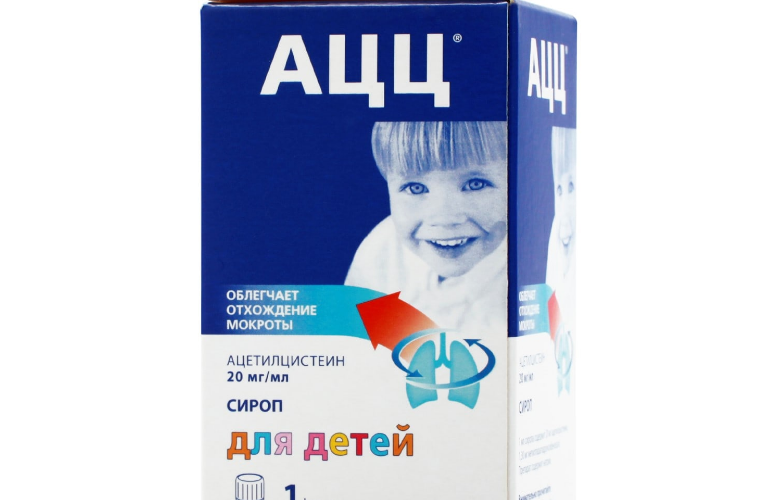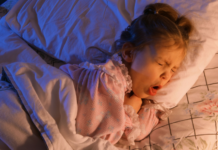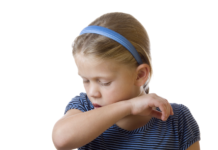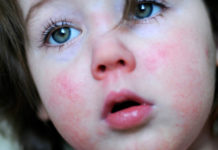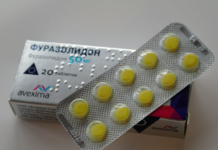“ACC” for children is produced by the international pharmaceutical company Sandoz. The medicine is used for diseases of the respiratory tract with strained cough, thick, difficult to separate sputum.
Material Content:
Composition and release forms
The drug contains one active component - acetylcysteine with the following medicinal properties:
- Mucolytic. The active substance changes the molecular structure of sputum, reduces density, facilitates the outflow of mucus from the respiratory tract.
- Anti-inflammatory and antioxidant. Acetylcysteine combines with free radicals, prevents the oxidation of cells of the mucous membranes of the respiratory system, which stops the inflammatory process.
- Detoxification. The active ingredient stimulates the production of glutathione, which restores damaged cells, removes toxic substances.
In pharmacies, 3 types of drug are dispensed without a prescription:
- White cylindrical tablets with blackberry flavor are sold in aluminum tubes of 20 pieces. There are 3 dosage options for acetylcysteine in one tablet: 100, 200, 600 mg. The composition is supplemented by soda, citric acid, lactose, vitamin C, sweeteners.
- Powder with the smell of citrus is packaged in bags, which are sold in boxes of 20 or 50 pieces. One packet of medicine contains 100 or 200 mg of the active substance, vitamin C, sucrose, flavoring.
- Cherry-flavored syrup is sold in tinted glass vials along with a syringe dispenser and a glass. One milliliter contains 20 mg of active substance.Additionally include water, preservatives E218, E211, a solution of sodium hydroxide and carmellose, saccharin, flavoring.
The “ACC” injection form is used in hospitals for severe illness, in pharmacies they are sold by prescription and used under the supervision of a treating pediatrician.
Indications for use of the drug
“ACC” is included in drug therapy for diseases of the upper and lower respiratory tract to alleviate cough and facilitate the release of mucus.
Among them:
- bronchitis on the background of acute respiratory viral infections, bacterial infections;
- obstructive pathologies of the lungs, bronchi;
- bronchial asthma;
- tracheitis;
- laryngotracheitis;
- bronchiectasis;
- bronchiolitis;
- pneumonia;
- lung abscess;
- cystic fibrosis;
- sinusitis;
- rhinitis;
- laryngitis;
- purulent otitis media.
"ATSTS" reduces the number of exacerbations, prolongs the stage of remission of chronic diseases of the bronchi, lungs.
At what age can children be given an ACC
The drug is allowed to treat babies from 2 years. The daily volume of the main component is calculated regardless of the form of the drug.
| Age of the child, years | Daily dose of acetylcysteine, mg |
|---|---|
| 2 – 5 | 200 – 300 |
| 6 – 14 | 300 – 400 |
| 14 and older | 400 – 600 |
For babies 1 and 2 years of age, the medicine is prescribed by the attending pediatrician, the dosage is calculated individually. With cystic fibrosis, the daily amount of the active ingredient is increased: for babies 2 - 5 years old - up to 400 mg, from 6 years old - up to 600, for children weighing more than 30 kg - up to 800.
Instructions for taking and dosage
During the course of treatment, the following recommendations are followed:
- The medicine is not given on an empty stomach to avoid irritation of the gastric mucosa.
- For the breeding of granules and tablets, they use a glass or ceramic mug to exclude contact of the finished medicine with metal, rubber.
- The child is abundantly watered with water, compote, fruit drinks, tea. The liquid enhances the mucolytic effect of the drug, stimulates the passage of mucus.
- In the evening, a medicine is offered 3 to 4 hours before falling asleep, so that the child has time to cough before bedtime.
The average course for acute inflammation lasts 1 week. The duration of admission in severe cases, complications, chronic diseases is determined by the doctor.
In syrup
Before using the “ACC” syrup, the required amount of medication is calculated:
| Age years | Single dose, ml | Number of receptions |
|---|---|---|
| 2 – 5 | 5 | 2 – 3 |
| 6 – 14 | 5 or 10 | 3 or 2 |
| 14+ | 10 | 2 – 3 |
The cap of the bubble is slightly pressed and unscrewed. The nozzle is removed from the syringe, inserted into the vial until it clicks, then inserted into the syringe. The container is turned upside down and the desired volume of the drug is pulled with a piston. When air bubbles appear, the drug is returned to the vial and recovered.
Syrup is given directly from the syringe, slowly squeezing the piston by the cheek, or pour into a spoon. The drug is not taken lying down, the child is seated or put on the floor. After taking the medicine, the syringe is thoroughly washed with running water.
In powder
A bag of “ACC” powder is dissolved in half a mug of any liquid: water, fruit drink, tea. The desired dose is determined by age:
| Age | Single dose, mg | Number of receptions |
|---|---|---|
| 2 – 5 | 1 sachet / 100 | 2 – 3 |
| 6 – 14 | 1 pp. / 100 or 1p. / 200 | 3 or 2 |
| 14+ | 1 p. / 200 | 2 – 3 |
The suspension is offered to the child immediately after dilution, you can store it for no longer than 3 hours.
In pills
The effervescent tablet “ACC” is dipped in a mug with 250 ml of water, taken when the drug is completely dissolved. The amount of medication is indicated in the table:
| Age | Single dose | Number of receptions |
|---|---|---|
| 2 – 5 | 1 tablet of ATSTS 100 | 2 – 3 |
| 6 – 14 | 1 t. ATSTS 100 or 1 t. ATSTs 200 | 3 or 2 |
| 14+ | 1 t. ATSTS 200 or 1 t. ATSTs 600 | 2 - 3 or 1 |
The finished solution can be stored for no longer than 2 hours, later it loses its healing properties.
Drug interaction
When taking the drug, the recommendations are taken into account:
- “ACC” is not mixed in the same circle with other medicines.
- Acetylcysteine makes absorption difficult and reduces the therapeutic effect of antibacterial agents, therefore, “ACC” and antibiotics are taken with a time interval of 2 to 3 hours.
- "ACC" is not combined with antitussive drugs that inhibit the cough center. Joint reception leads to stagnation of mucus and complications.
- Acetylcysteine enhances the vasodilating effect of vasodilating drugs.
- Activated carbon and other sorbents reduce the therapeutic effect of the drug.
- The mucolytic properties of “ACC” are enhanced when taken together with bronchodilators.
Contraindications, side effects and overdose
- The medicine is excluded or taken with caution in the following conditions:
- Allergy to the components of the drug.
- Violation of the breakdown and absorption of galactose, glucose, fructose.
- Ulcer, gastrointestinal erosion in the acute stage.
- Pulmonary hemorrhage, sputum production with streaks of blood.
- In children with bronchial asthma and allergic bronchitis, airway patency is constantly monitored.
- With diabetes, they monitor the level of glucose in the blood: the drug contains carbohydrates.
- In case of kidney and liver failure, the child's condition is monitored by blood and urine tests.
If you strictly follow the instructions for use, side effects are rarely noted, they include:
- Allergy manifestations: urticaria, itching, rash, redness, angioedema, anaphylactic shock.
- Violation of the respiratory system: bronchospasms and shortness of breath, more often with asthma.
- Gastrointestinal Disorder: nausea, loose stools, redness, sores of the oral mucosa, pain in the stomach.
- Failures of the cardiovascular system: heart palpitations, lowering blood pressure.
- Headaches, ear noise, and fever are extremely rare.
In case of an overdose, signs of a digestive tract disorder appear: nausea, vomiting, diarrhea. The child is washed the stomach, stop giving medicine.
Analogs of the ACC
If the child has signs of allergy, the “ACC” is replaced with a mucolytic drug with another active substance:
- "Bromhexine" is based on bromhexine hydrochloride. Syrup is used for babies from 2 years old, tablets - from 6.
- "Ambroxol" is found in the form of tablets, a solution for inhalation and injection, syrup. The medicine is allowed to treat babies from birth, even premature babies.
- "Ambrobene" is used for infants from the first days of life, but under the supervision of a pediatrician.
- Syrup "Fluifort" is produced on the basis of carbocysteine, prescribed for babies from 1 year.
- “Lazolvan" is allowed to be given to infants from birth, the dosage is determined by the attending physician, the active component of the drug is ambroxol.
- Syrup "Sudafed" is allowed for children from 2 years old, the active substance of the drug is pseudoephedrine, guaifenesin.
- Flavamed in the form of a solution for internal use is allowed for children from 1 month of age, tablets are prescribed from 6 years old, effervescent tablets from 12 years old, the main component of the drug is ambroxol hydrochloride.
Reviews of parents confirm the therapeutic effect of “ACC” from cough. Improvement occurs at the end of the first day: the mucus liquefies, is more easily removed from the respiratory tract. After 5 - 7 days, the child softens and the cough gradually passes. Any drugs have contraindications, so they are not given to children without the appointment of a doctor.



